
Smithfield is a town in Isle of Wight County, in the South Hampton Roads subregion of the Hampton Roads region of Virginia in the United States. The population was 8,533 at the 2020 census.

Yorktown is a census-designated place (CDP) in York County, Virginia. It is the county seat of York County, one of the eight original shires formed in colonial Virginia in 1682. Yorktown's population was 195 as of the 2010 census, while York County's population was 66,134 in the 2011 census estimate.

Thomas Nelson Jr. was a Founding Father of the United States, general in the Revolutionary War, member of the Continental Congress, and a Virginia planter. In addition to serving many terms in the Virginia General Assembly, he twice represented Virginia in the Congress, where he signed the Declaration of Independence in 1776. Fellow Virginia legislators elected him to serve as the commonwealth's governor in 1781, the same year he fought as a brigadier general in the siege of Yorktown, the final battle of the war.
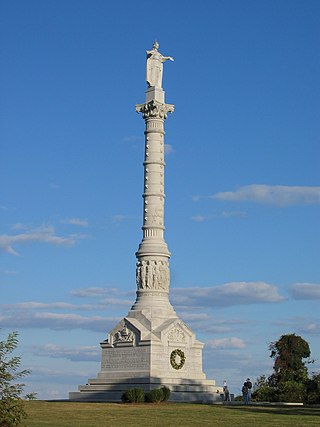
Colonial National Historical Park is a large national historical park located in the Hampton Roads region of Virginia operated by the National Park Service. It protects and interprets several sites relating to the Colony of Virginia and the history of the United States more broadly. These range from the site of the first English settlement at Jamestown, to the battlefields of Yorktown where the British Army was defeated in the American Revolutionary War. Over 3 million people visit the park each year.
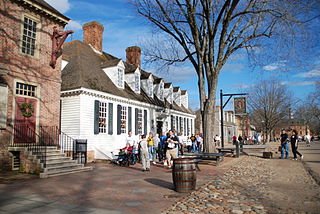
Colonial Williamsburg is a living-history museum and private foundation presenting a part of the historic district in the city of Williamsburg, Virginia. Its 301-acre (122 ha) historic area includes several hundred restored or recreated buildings from the 18th century, when the city was the capital of the Colony of Virginia; 17th-century, 19th-century, and Colonial Revival structures; and more recent reconstructions. The historic area includes three main thoroughfares and their connecting side streets that attempt to suggest the atmosphere and the circumstances of 18th-century Americans. Costumed employees work and dress as people did in the era, sometimes using colonial grammar and diction.
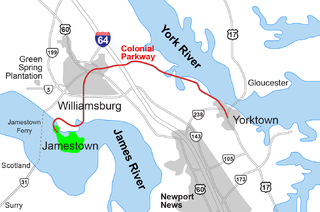
The Historic Triangle includes three historic colonial communities located on the Virginia Peninsula of the United States and is bounded by the York River on the north and the James River on the south. The points that form the triangle are Jamestown, Colonial Williamsburg, and Yorktown. They feature many restored attractions and are linked by the Colonial Parkway in James City and York counties, and the City of Williamsburg.

Westover Plantation is a historic colonial tidewater plantation located on the north bank of the James River in Charles City County, Virginia. Established in c. 1730–1750, it is the homestead of the Byrd family of Virginia. State Route 5, a scenic byway, runs east–west to the north of the plantation, connecting the independent cities of Richmond and Williamsburg.
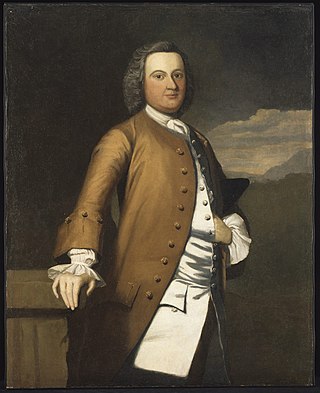
William Nelson was an American planter, politician, and colonial leader from Yorktown, Virginia. In the interim between the royal governors Norborne Berkeley and Lord Dunmore, he served as governor of colonial Virginia in 1770 and 1771.

Guilford Courthouse National Military Park, at 2332 New Garden Road in Greensboro, Guilford County, North Carolina, commemorates the Battle of Guilford Court House, fought on March 15, 1781. This battle opened the campaign that led to American victory in the Revolutionary War. Though they won the battle, the casualties suffered by the British in this battle contributed to their surrender at Yorktown seven months later. The battlefield is preserved as a National Military Park and operated by the National Park Service (NPS). Based on research of historical evidence, the interpretation of the battle has changed since the late 20th century, which will affect the placement of monuments and markers.
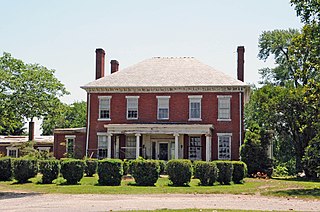
Varina Farms, also known as Varina Plantation or Varina Farms Plantation or Varina on the James, is a plantation established in the 17th century on the James River about 10 miles (16 km) south of Richmond, Virginia. An 820-acre (330 ha) property was listed on the National Register of Historic Places in 1977 as "Varina Plantation". At that time it included two contributing buildings and one other contributing site.

Endview Plantation is an 18th-century plantation, including a park and historic home now operated by the independent city of Newport News, Virginia, located on Virginia State Route 238 in the Lee Hall community.

Buildings, sites, districts, and objects in Virginia listed on the National Register of Historic Places:

Elsing Green Plantation, a National Historic Landmark and wildlife refuge, rests upon nearly 3,000 acres (1,200 ha) along the Pamunkey River in King William County, Virginia, a rural county on the western end of the state's middle peninsula, approximately 33 miles (53 km) northeast of the Richmond. The 18th-century plantation, now owned by the Lafferty family, has been in continuous operation for more than 300 years. In addition to the plantation house, dependency buildings and cultivated land, Elsing Green includes 2,454 acres (993 ha) of surrounding farmland, forest and marsh land. Elsing Green has been on the Virginia Landmarks Register and the National Register of Historic Places since 1969, and received formal National Historic Landmark status in 1971.
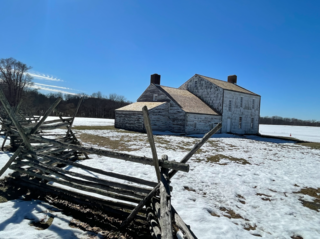
Monmouth Battlefield State Park is a 1,818-acre (7.36 km2) New Jersey state park located on the border of Manalapan and Freehold Township, in Monmouth County, New Jersey, United States. This park preserves the historical battlefield on which the American Revolutionary War's Battle of Monmouth (1778) was waged. It was added to the National Register of Historic Places for its significance in military history.

Rosewell Plantation in Gloucester County, Virginia, was for more than 100 years the home of a branch of the Page family, one of the First Families of Virginia. Begun in 1725, the Flemish bond brick Rosewell mansion overlooking the York River was one of the most elaborate homes in the American colonies.

The Joseph Webb House is a historic Georgian-style house at 211 Main Street in Wethersfield, Connecticut. It was designated a National Historic Landmark for its significance as the location of the five-day military conference between George Washington and French commander Rochambeau in 1781 during the American Revolutionary War that preceded the Siege of Yorktown, the last major battle of the war. Washington lodged at the house of Joseph Webb on May 17, 1781 in Old Wethersfield. The Joseph Webb House is owned by the Webb-Deane-Stevens Museum and serves as its headquarters. The interior has been restored to an 18th-century appearance and the grounds feature a Colonial Revival garden and 19th-century barn in back.
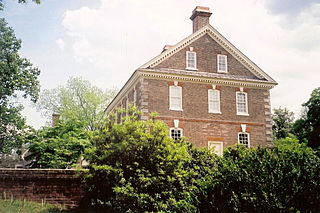
Thomas "Scotch Tom" Nelson (1677–1747) was a businessman and politician who immigrated from England to become a merchant at Yorktown in the Colony of Virginia. He was from Penrith, Cumberland. Arriving at the beginning of the 18th century, he was the immigrant ancestor of the Nelsons, one of the First Families of Virginia.

Belle Grove Plantation is a late-18th-century plantation house and estate in the northern Shenandoah Valley of Virginia, USA. It is situated in Frederick County, about a mile southwest of Middletown.

The Moore House is a historic building located within Colonial National Historical Park, in York County, Virginia. During the American Revolutionary War, it was the site of negotiations for British General Charles Cornwallis's surrender at the Siege of Yorktown.
Thomas Pate was a British merchant who became a planter, military officer, ferry owner and politician who served a term as burgess representing Gloucester County in the House of Burgesses. Rebel Nathaniel Bacon commandeered this man's house in Gloucester County during Bacon's Rebellion, and later Governor Howard also lived there. Across Mobjack Bay, the restored historic Yorktown home once named after this man is now renamed the "Cole Digges" house after a politically powerful successor owner and resident since recent archeological research indicates it was probably built decades after this man's death.






















